The Shōgun (将軍, Japanese: [ɕoːɡɯɴ] (listen); English: /ˈʃoʊɡʌn/ SHOH-gun) was the military dictator of Japan during most of the period spanning from 1185 to 1868. Nominally appointed by the Emperor, shōguns were usually the de facto rulers of the country, though during part of the Kamakura period shōguns were themselves figureheads. The office of shōgun was in practice hereditary, though over the course of the history of Japan several different clans held the position. Shōgun is the short form of Sei-i Taishōgun (征夷大将軍, "Commander-in-Chief of the Expeditionary Force Against the Barbarians"), a high military title from the Heian period and can be roughly equated with the Western rank of Generalissimus. When Minamoto no Yoritomo gained political ascendency over Japan in 1185, the title was revived to regularize his position, making him the first shōgun in the usually understood sense. The shōgun's officials were collectively referred to as the bakufu, or tent government; they were the ones who carried out the actual duties of administration, while the Imperial court retained only nominal authority. The tent symbolized the shōgun's role as the military's field commander, but also denoted that such an office was meant to be temporary. Nevertheless, the institution, known in English as the shogunate (English: /ˈʃoʊɡəneɪt/ SHOH-gə-nayt), persisted for nearly 700 years, ending when Tokugawa Yoshinobu relinquished the office to Emperor Meiji in 1867 as part of the Meiji Restoration.
- shōgun#39s
- shōgun
- japan
1. Etymology
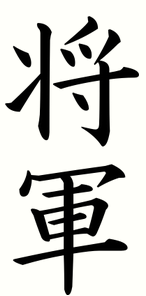
The term shōgun (将軍, lit. «army commander»), composed of the kanji 将, which means «commander»[1] and 軍 which means «army»,[2] is the abbreviation of the historical title Seii Taishōgun (征夷大将軍, lit. «Great appeasing general of the barbarians»), which was used to refer to the general who commanded the army sent to fight the tribes of northern Japan. After the twelfth century, the term was used to designate the leader of the samurai.[3]
The administration of a shōgun is called bakufu (幕府) In Japanese and literally means "government from the maku." During the battles, the head of the samurai army used to be sitting in a scissor chair inside a semi-open tent called maku that exhibited its respective mon or blazon. The application of the term bakufu to the shōgun government shows an extremely strong and representative symbolism.[4]
2. Titles
Historically, similar terms to Seii Taishōgun were used with varying degrees of responsibility, although none of them had equal or more importance than Seii Taishōgun. Some of them were:
- Seitō Taishōgun (征東大将軍, lit. «Commander in chief for the pacification of the East») [5]
- Seisei Taishōgun (征西大将軍, lit. «Commander in chief for the pacification of the West») [6]
- Chinjufu Shōgun (鎮守府将軍, lit. «Commander in chief of the central peacekeeping headquarters») [7]
- Seiteki Taishōgun (征狄大将軍, lit. «Great Barbarian Subjugator General»)
- Mochisetsu Taishōgun (持節大将軍, lit. «Grand general of temporary office»)
- Sekke shōgun (摂家将軍, lit. «Grand General Counselor») [8]
- Miya shōgun (宮将軍, lit. «Grand Palace General») [9]
3. History
3.1. First Shogun
There is no consensus among the various authors since some sources consider Tajihi no Agatamori the first, others say Ōtomo no Otomaro, other sources assure that the first was Sakanoue no Tamuramaro, while others avoid the problem by just mentioning from the first Kamakura shogun Minamoto no Yoritomo.
3.2. Heian Period (794–1185)
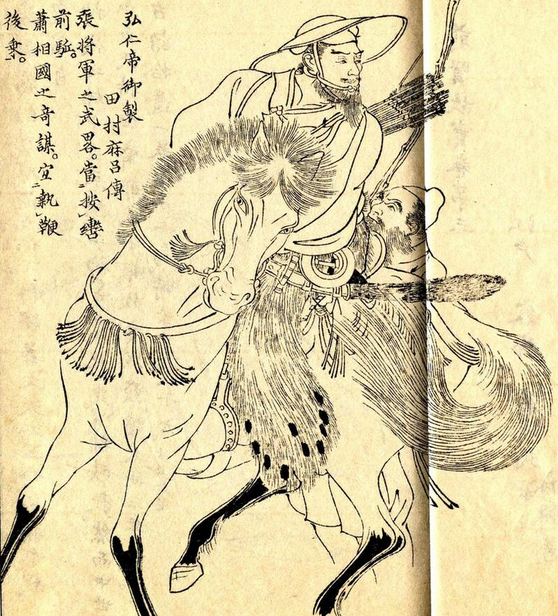
Originally, the title of Sei-i Taishōgun ("Commander-in-Chief of the Expeditionary Force Against the Barbarians")[10] was given to military commanders during the early Heian period for the duration of military campaigns against the Emishi, who resisted the governance of the Kyoto-based imperial court. Ōtomo no Otomaro was the first Sei-i Taishōgun.[11] The most famous of these shōguns was Sakanoue no Tamuramaro.
In the later Heian period, one more shōgun was appointed. Minamoto no Yoshinaka was named sei-i taishōgun during the Genpei War, only to be killed shortly thereafter by Minamoto no Yoshitsune.
Sakanoue no Tamuramaro
Sakanoue no Tamuramaro (758-811)[12] was a Japanese general who fought against the tribes of northern Japan (settled in the territory that today integrates the provinces of Mutsu and Dewa). Tamarumaro was the first general to bend these tribes, integrating its territory to that of the Japanese State. For his military feats he was named Seii Taishōgun and probably because he was the first to win the victory against the northern tribes he is generally recognized as the first shōgun in history.[12][13][14] (Note: according to historical sources Ōtomo no Otomaro also had the title of Seii Taishōgun).
3.3. Kamakura Shogunate (1192–1333)
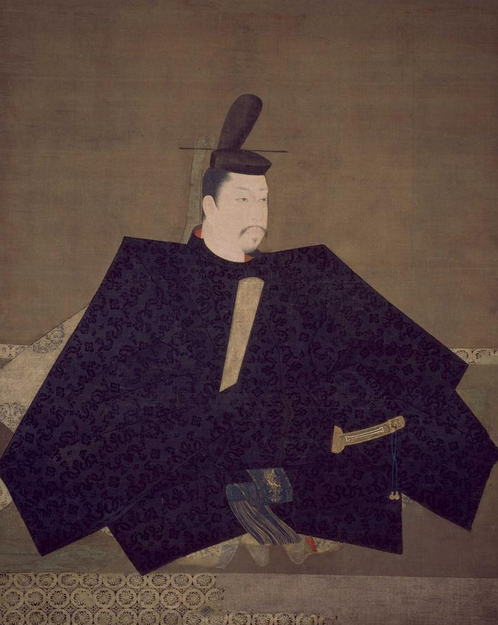
In the early 11th century, daimyō protected by samurai came to dominate internal Japanese politics.[15] Two of the most powerful families – the Taira and Minamoto – fought for control over the declining imperial court. The Taira family seized control from 1160 to 1185, but was defeated by the Minamoto in the Battle of Dan-no-ura. Minamoto no Yoritomo seized power from the central government and aristocracy and established a feudal system based in Kamakura in which the private military, the samurai, gained some political powers while the Emperor and the aristocracy remained the de jure rulers. In 1192, Yoritomo was awarded the title of Sei-i Taishōgun by Emperor Go-Toba and the political system he developed with a succession of shōguns as the head became known as a shogunate. Yoritomo's wife's family, the Hōjō, seized power from the Kamakura shōguns.[16] When Yoritomo's sons and heirs were assassinated, the shōgun himself became a hereditary figurehead. Real power rested with the Hōjō regents. The Kamakura shogunate lasted for almost 150 years, from 1192 to 1333.
The end of the Kamakura shogunate came when Kamakura fell in 1333, and the Hōjō Regency was destroyed. Two imperial families – the senior Northern Court and the junior Southern Court – had a claim to the throne. The problem was solved with the intercession of the Kamakura shogunate, who had the two lines alternate. This lasted until 1331, when Emperor Go-Daigo (of the Southern Court) tried to overthrow the shogunate to stop the alternation. As a result, Daigo was exiled. Around 1334–1336, Ashikaga Takauji helped Daigo regain his throne.[17]
The fight against the shogunate left the Emperor with too many people claiming a limited supply of land. Takauji turned against the Emperor when the discontent about the distribution of land grew great enough. In 1336 Daigo was banished again, in favor of a new Emperor.[17]
During the Kenmu Restoration, after the fall of the Kamakura shogunate in 1333, another short-lived shōgun arose. Prince Moriyoshi (Morinaga), son of Go-Daigo, was awarded the title of Sei-i Taishōgun. However, Prince Moriyoshi was later put under house arrest and, in 1335, killed by Ashikaga Tadayoshi.
3.4. Ashikaga Shogunate (1336–1573)

In 1338, Ashikaga Takauji, like Minamoto no Yoritomo, a descendant of the Minamoto princes, was awarded the title of sei-i taishōgun and established the Ashikaga shogunate, which nominally lasted until 1573. The Ashikaga had their headquarters in the Muromachi district of Kyoto, and the time during which they ruled is also known as the Muromachi period.
3.5. Azuchi–Momoyama Period (1573–1600)
While the title of Shōgun went into abeyance due to technical reasons, Oda Nobunaga and his successor, Toyotomi Hideyoshi, who later obtained the position of Imperial Regent, gained far greater power than any of their predecessors had. Hideyoshi is considered by many historians to be among Japan's greatest rulers.
3.6. Tokugawa Shogunate (1600–1868)
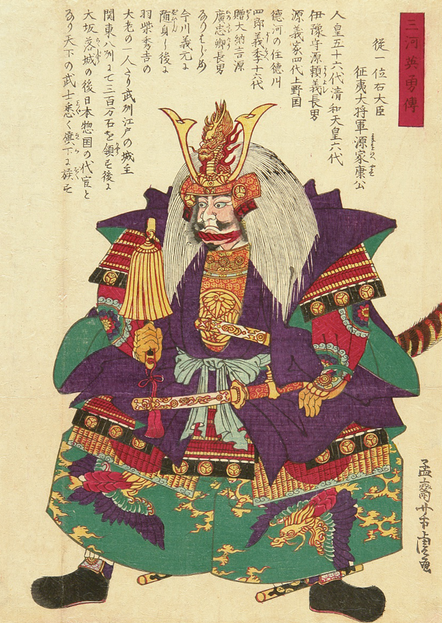
Tokugawa Ieyasu seized power and established a government at Edo (now known as Tokyo) in 1600. He received the title sei-i taishōgun in 1603, after he forged a family tree to show he was of Minamoto descent.[18] The Tokugawa shogunate lasted until 1867, when Tokugawa Yoshinobu resigned as shōgun and abdicated his authority to Emperor Meiji.[19] Ieyasu set a precedent in 1605 when he retired as shōgun in favour of his son Tokugawa Hidetada, though he maintained power from behind the scenes as Ōgosho (大御所, cloistered shōgun).[20]
During the Edo period, effective power rested with the Tokugawa shōgun, not the Emperor in Kyoto, even though the former ostensibly owed his position to the latter. The shōgun controlled foreign policy, the military, and feudal patronage. The role of the Emperor was ceremonial, similar to the position of the Japanese monarchy after the Second World War.[21]
4. Timelines
4.1. Timeline of the Kamakura Shogunate
<timeline> ImageSize = width:800 height:auto barincrement:12 PlotArea = top:10 bottom:30 right:130 left:20 AlignBars = early
DateFormat = yyyy Period = from:1190 till:1335 TimeAxis = orientation:horizontal ScaleMajor = unit:year increment:20 start:1190
Colors =
id:canvas value:rgb(0.97,0.97,0.97) id:PA value:green id:GP value:red
Backgroundcolors = canvas:canvas
BarData =
barset:Shogun
PlotData=
width:5 align:left fontsize:S shift:(5,-4) anchor:till barset:Shogun from:1192 till:1199 color:PA text:"Yoritomo (1192 – 1199)" from:1202 till:1203 color:PA text:"Yoriie (1202 – 1203)" from:1203 till:1219 color:PA text:"Sanetomo (1203 – 1219)" from:1226 till:1244 color:PA text:"Yoritsune (1226 – 1244)" from:1244 till:1252 color:PA text:"Yoritsugu (1244 – 1252)" from:1252 till:1266 color:PA text:"Munetaka (1252 – 1266)" from:1266 till:1289 color:PA text:"Koreyasu (1266 – 1289)" from:1289 till:1308 color:PA text:"Hisaaki (1289 – 1308)" from:1308 till:1333 color:PA text:"Morikuni (1308 – 1333)" barset:skip
</timeline>
4.2. Timeline of the Ashikaga Shogunate
<timeline> ImageSize = width:800 height:auto barincrement:12 PlotArea = top:10 bottom:30 right:130 left:20 AlignBars = early
DateFormat = yyyy Period = from:1330 till:1575 TimeAxis = orientation:horizontal ScaleMajor = unit:year increment:25 start:1338
Colors =
id:canvas value:rgb(0.97,0.97,0.97) id:PA value:red id:GP value:red
Backgroundcolors = canvas:canvas
BarData =
barset:Shogun
PlotData=
width:5 align:left fontsize:S shift:(5,-4) anchor:till barset:Shogun from:1338 till:1358 color:PA text:"Takauji (1338 – 1358)" from:1358 till:1367 color:PA text:"Yoshiakira (1358 – 1367)" from:1368 till:1394 color:PA text:"Yoshimitsu (1368 – 1394)" from:1394 till:1423 color:PA text:"Yoshimochi (1394 – 1423)" from:1423 till:1425 color:PA text:"Yoshikazu (1423 – 1425)" from:1429 till:1441 color:PA text:"Yoshinori (1429 – 1441)" from:1442 till:1443 color:PA text:"Yoshikatsu (1442 – 1443)" from:1449 till:1473 color:PA text:"Yoshimasa (1449 – 1473)" from:1473 till:1489 color:PA text:"Yoshihisa (1473 – 1489)" from:1490 till:1493 color:PA text:"Yoshitane (1490 – 1493)" from:1494 till:1508 color:PA text:"Yoshizumi (1494 – 1508)" from:1508 till:1521 color:PA text:"Yoshitane (1508 – 1521)" from:1521 till:1546 color:PA text:"Yoshiharu (1521 – 1546)" from:1546 till:1565 color:PA text:"Yoshiteru (1546 – 1565)" from:1568 till:1568 color:PA text:"Yoshihide (1568)" from:1568 till:1573 color:PA text:"Yoshiaki (1568 – 1573)" barset:skip
</timeline>
4.3. Timeline of the Tokugawa Shogunate
<timeline> ImageSize = width:800 height:auto barincrement:12 PlotArea = top:10 bottom:30 right:130 left:20 AlignBars = early
DateFormat = yyyy Period = from:1600 till:1870 TimeAxis = orientation:horizontal ScaleMajor = unit:year increment:25 start:1600
Colors =
id:canvas value:rgb(0.97,0.97,0.97) id:PA value:blue id:GP value:red
Backgroundcolors = canvas:canvas
BarData =
barset:Shogun
PlotData=
width:5 align:left fontsize:S shift:(5,-4) anchor:till barset:Shogun from:1603 till:1605 color:PA text:"Ieyasu (1603 – 1605)" from:1605 till:1623 color:PA text:"Hidetada (1605 – 1623)" from:1623 till:1651 color:PA text:"Iemitsu (1623 – 1651)" from:1651 till:1680 color:PA text:"Ietsuna (1651 – 1680)" from:1680 till:1709 color:PA text:"Tsunayoshi (1680 – 1709)" from:1709 till:1712 color:PA text:"Ienobu (1709 – 1712)" from:1713 till:1716 color:PA text:"Ietsugu (1713 – 1716)" from:1716 till:1745 color:PA text:"Yoshimune (1716 – 1745)" from:1745 till:1760 color:PA text:"Ieshige (1745 – 1760)" from:1760 till:1786 color:PA text:"Ieharu (1760 – 1786)" from:1786 till:1837 color:PA text:"Ienari (1787 – 1837)" from:1837 till:1853 color:PA text:" Ieyoshi (1837 – 1853)" from:1853 till:1858 color:PA text:" Iesada (1853 – 1858)" from:1858 till:1866 color:PA text:" Iemochi (1858 – 1866)" from:1867 till:1868 color:PA text:" Yoshinobu (1867 – 1868)" barset:skip
</timeline>
5. Shogunate
The term bakufu (幕府, "tent government") originally meant the dwelling and household of a shōgun, but in time, became a metonym for the system of government of a feudal military dictatorship, exercised in the name of the shōgun or by the shōgun himself. Therefore, various bakufu held absolute power over the country (territory ruled at that time) without pause from 1192 to 1867, glossing over actual power, clan and title transfers.
The shogunate system was originally established under the Kamakura shogunate by Minamoto no Yoritomo. Although theoretically, the state (and therefore the Emperor) held ownership of all land in Japan. The system had some feudal elements, with lesser territorial lords pledging their allegiance to greater ones. Samurai were rewarded for their loyalty with agricultural surplus, usually rice, or labor services from peasants. In contrast to European feudal knights, samurai were not landowners.[22] The hierarchy that held this system of government together was reinforced by close ties of loyalty between the daimyōs, samurai and their subordinates.
Each shogunate was dynamic, not static. Power was constantly shifting and authority was often ambiguous. The study of the ebbs and flows in this complex history continues to occupy the attention of scholars. Each shogunate encountered competition. Sources of competition included the Emperor and the court aristocracy, the remnants of the imperial governmental systems, the daimyōs, the shōen system, the great temples and shrines, the sōhei, the shugo and jitō, the jizamurai and early modern daimyō. Each shogunate reflected the necessity of new ways of balancing the changing requirements of central and regional authorities.[23]
6. Relationship with the Emperor
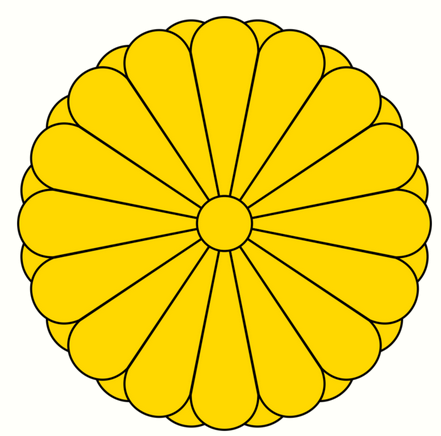
Since Minamoto no Yoritomo turned the figure of the shōgun into a permanent and hereditary position and until the Meiji Restoration there were two ruling classes in Japan: 1. the emperor or tennō (天皇, lit. «Heavenly Sovereign»),[24] who acted as «chief priest» of the official religion of the country, Shinto, and 2. the shōgun, head of the army who also enjoyed civil, military, diplomatic and judicial authority.[25] Although in theory the shōgun was an emperor's servant, it became the true power behind the throne.[26]
No shōgun tried to usurp the throne, even when they had at their disposal the military power of the territory. There were two reasons primarily:[27]
- Theoretically the shōgun received the power of the emperor, so this was his symbol of authority.
- There was a sentimentalist tradition created by priests and religious who traced the imperial line from the "age of the gods" into an "eternal line unbroken by the times." According to Japanese mythology, the emperor was a direct descendant of Amaterasu, goddess of the sun.
Unable to usurp the throne, the Shoguns sought throughout history to keep the emperor away from the country's political activity, relegating them from the sphere of influence. One of the few powers that the imperial house could retain was that of being able to "control time" through the designation of the Japanese Nengō or Eras and the issuance of calendars.[28]
This is a highlight of two historical attempts of the emperor to recover the power they enjoyed before the establishment of the shogunate. In 1219 the Emperor Go-Toba accused the Hōjō as outlaws. Imperial troops mobilized, leading to the Jōkyū War (1219-1221), which would culminate in the third Battle of Uji (1221). During this, the imperial troops were defeated and the emperor Go-Toba was exiled.[29] With the defeat of Go-Toba, the samurai government over the country was confirmed.[29] At the beginning of the fourteenth century the Emperor Go-Daigo decided to rebel, but the Hōjō, who were then regents, sent an army from Kamakura. The emperor fled before the troops arrived and took the imperial insignia.[30] The shōgun named his own emperor, giving rise to the era Nanbokuchō (南北朝, lit. «Southern and Northern Courts»).
During the 1850s and 1860s, the shogunate was severely pressured both abroad and by foreign powers. It was then that various groups angry with the shogunate for the concessions made to the various European countries found in the figure of the emperor an ally through which they could expel the Tokugawa shogunate from power. The motto of this movement was Sonnō jōi (尊王攘夷, «Revere the Emperor, Eject the Barbarians») and they finally succeeded in 1868, when imperial power was restored after centuries of being in the shadow of the country's political life.[31]
7. Legacy
Upon Japan's surrender after World War II, American Army General Douglas MacArthur became Japan's de facto ruler during the years of occupation. So great was his influence in Japan that he has been dubbed the Gaijin Shōgun (外人将軍).[32]
Today, the head of the Japanese government is the Prime Minister; the usage of the term "shōgun" has nevertheless continued in colloquialisms. A retired Prime Minister who still wields considerable power and influence behind the scenes is called a "shadow shōgun" (闇将軍, yami shōgun),[33] a sort of modern incarnation of the cloistered rule. Examples of "shadow shōguns" are former Prime Minister Kakuei Tanaka and the politician Ichirō Ozawa.[34]
The content is sourced from: https://handwiki.org/wiki/Social:Sh%C5%8Dgun
References
- "Yamasa Online Kanji Dictionary". http://www.yamasa.cc/members/ocjs/kanjidic.nsf/542e273e7326836c49256b0400118691/5806e0490bfe5e2d49256a90002ec196!OpenDocument.
- "Yamasa Online Kanji Dictionary". http://www.yamasa.cc/members/ocjs/kanjidic.nsf/542e273e7326836c49256b0400118691/b38b19bee7c7817749256a90002ebfc7!OpenDocument.
- Turnbull, 2006a:21 & 22.
- Turnbull, 2006a:207.
- Friday, 2007:108.
- Hall, 1991:241.
- Adolphson, 2007:341.
- Ishii, 2002:2396.
- Ishii, 2002:2467.
- The Modern Reader's Japanese-English Character Dictionary, ISBN:0-8048-0408-7
- "Error: no |title= specified when using {{Cite web}}" (in Japanese). Books Kinokuniya. http://bookweb.kinokuniya.co.jp/htm/4121008332.html. Retrieved March 7, 2011.
- De Bary et al., 2001:266.
- Andressen & Osborne, 2002:48.
- Ramirez-faria, 283.
- "Shogun". The World Book Encyclopedia. 17. World Book. 1992. pp. 432–433. ISBN 0-7166-0092-7.
- "shogun | Japanese title" (in en). Encyclopedia Britannica. https://www.britannica.com/topic/shogun.
- Sansom, George (1961). A History of Japan, 1134–1615. United States: Stanford University Press. http://www.gotterdammerung.org/books/reviews/h/history-of-japan-1334-1615.html.
- Titsingh, I. (1834). Annales des empereurs du Japon, p. 409.
- "Japan". The World Book Encyclopedia. World Book. 1992. pp. 34–59. ISBN 0-7166-0092-7.
- Nussbaum, "Ogosho" at p. 738. https://books.google.com/books?id=p2QnPijAEmEC&pg=PA738&dq=
- Wakabayashi, Bob Tadashi (Winter 1991). "In Name Only: Imperial Sovereignty in Early Modern Japan". Journal of Japanese Studies 17 (1): 25–57. doi:10.2307/132906. https://dx.doi.org/10.2307%2F132906
- Bentley, Jerry. Traditions and Encounters. pp. 301–302. ISBN 978-0-07-325230-8.
- Mass, J. et al., eds. (1985). The Bakufu in Japanese History, p. 189.
- Mitchelhill & Green, 2003:59.
- Kuno, 2007:245.
- Davis, 2001:205.
- Roth, 2007:103.
- Fiévé & Waley, 2003:235.
- Turnbull, 2006a:41.
- Turnbull, 2006a:43.
- Fiévé & Waley, 2003:236.
- Valley, David J. (April 15, 2000). Gaijin Shogun : Gen. Douglas MacArthur Stepfather of Postwar Japan. Title: Sektor Company. ISBN 978-0967817521. https://www.amazon.com/Gaijin-Shogun-Douglas-MacArthur-Stepfather/dp/0967817528. Retrieved 2 June 2017.
- "闇将軍". https://kotobank.jp/word/%E9%97%87%E5%B0%86%E8%BB%8D-673934.
- Ichiro Ozawa: the shadow shogun. In: The Economist, September 10, 2009.
